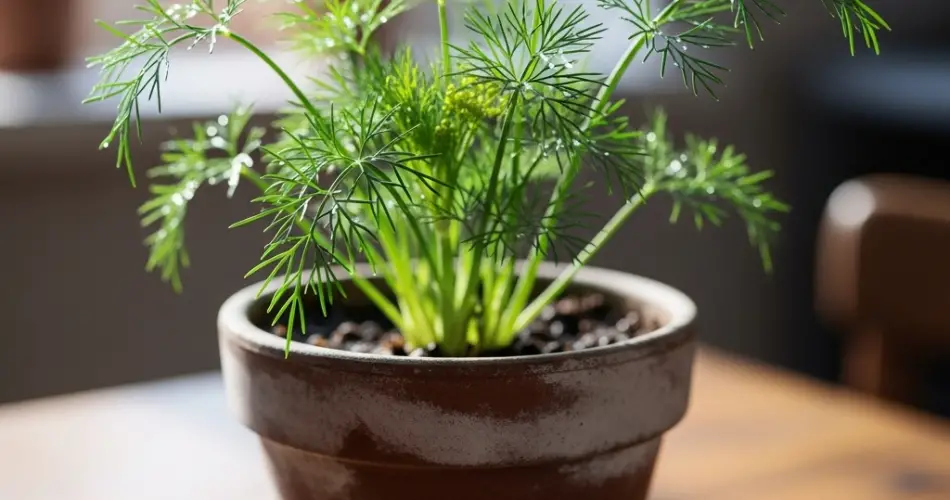Dill is one of the most delightful herbs to grow, bringing both fragrance and flavor to your garden and kitchen. Its airy, feathery leaves and umbrella-like flower heads make it as beautiful as it is useful. Whether you use it for seasoning fish, soups, or homemade pickles, fresh dill adds a distinct taste that’s hard to beat.
When grown in containers, dill often grows tall and slender, sometimes reaching up to three feet depending on the variety. While its delicate stems give the plant a graceful look, they can also make it prone to toppling over, especially in pots where space is limited and wind exposure is greater. Supporting dill in containers is a simple but important step to keep plants healthy, upright, and productive.
This article covers practical ways to provide support for tall dill stalks, along with tips to help them thrive in small-space gardens.
Why Dill Needs Support in Containers
In the garden, dill has the advantage of surrounding soil to anchor its long taproot and provide stability. In containers, however, the root system is limited to the space of the pot. Combined with tall, lightweight stalks, this makes dill more likely to bend or fall, especially when it begins producing flower heads that add extra weight.
Windy balconies, patios, or windowsills can also contribute to the problem. Without support, stalks may snap or lean, leading to less healthy growth and a shorter harvest window. Providing support ensures that your dill remains upright, attractive, and easy to harvest.
Choosing the Right Support System
There are several ways to support dill plants in containers, and most require only simple materials you may already have at home.
1. Bamboo Stakes or Wooden Dowels
One of the easiest methods is to insert thin bamboo stakes or wooden dowels into the pot alongside the dill. Use soft plant ties, twine, or even strips of cloth to loosely secure the stalks to the stake. Be careful not to tie them too tightly—dill stems are delicate and can bruise easily.
2. Small Tomato Cages
For larger pots, you can place a small tomato cage over the dill as it grows. The circular shape provides support on all sides, keeping multiple stalks upright. This works especially well if you are growing several dill plants in a single container.
3. Decorative Trellises
Compact garden trellises not only support tall dill but also add an ornamental touch to your container garden. They are particularly useful for mixed plantings where dill shares space with other herbs.
4. DIY Supports
Household items like chopsticks, skewers, or even wire hangers can be repurposed into plant supports. For smaller dill plants or dwarf varieties, these lightweight solutions often provide just the right level of support.
Planting Techniques That Help with Stability
While physical supports are essential, you can also encourage stronger, more stable dill plants through careful planting practices.
-
Choose a deep pot: Dill has a long taproot that needs depth. A container at least 12 inches deep allows the roots to anchor better.
-
Don’t overcrowd: Growing too many plants in one pot can weaken them and increase the risk of falling over. Thin seedlings so each plant has enough room.
-
Stagger sowing: Instead of planting all seeds at once, sow in intervals. This prevents all the plants from growing tall at the same time, which makes management easier.
Watering and Fertilizing for Strong Stalks
Watering is critical for dill in containers. Allow the top inch of soil to dry out before watering deeply. Too much water can cause weak stems, while underwatering can stress the plant and make it more fragile.
When it comes to feeding, use a light hand. A diluted, balanced liquid fertilizer every 3 to 4 weeks is usually sufficient. Overfertilizing, especially with nitrogen, can result in tall, leggy plants that are even more likely to topple.
Harvesting Without Weakening the Plant
Regular harvesting actually helps maintain healthier dill plants. Snip leaves from the top and sides once the plant reaches about 8 inches in height. This encourages bushier growth and reduces the plant’s tendency to stretch too tall too quickly.
When the flower heads start forming, you can choose to let them develop for seeds or pinch them off to prolong leaf production. Flowering usually makes the plant taller and more top-heavy, so if you keep the plant in the leafy stage, it will remain more compact and easier to manage.
Protecting Dill from Wind
If you are growing dill on a windy balcony or patio, consider placing pots near a wall or railing for shelter. Grouping several pots together can also help reduce exposure and provide mutual support for tall plants. For extra protection, you might move containers indoors during storms or particularly breezy days.
Conclusion
Supporting tall dill stalks in containers is a simple but effective way to ensure your plants stay upright, healthy, and productive. With a deep pot, proper planting techniques, and the use of stakes, cages, or trellises, you can prevent fragile stems from bending or breaking. Combined with thoughtful watering, moderate feeding, and regular harvesting, these strategies will help you enjoy lush dill plants that not only look beautiful but also provide a steady supply of fragrant leaves and flavorful seeds.
Even in the smallest garden spaces, a little care and support allow dill to grow tall with ease—bringing fresh, feathery greenery right to your doorstep.



